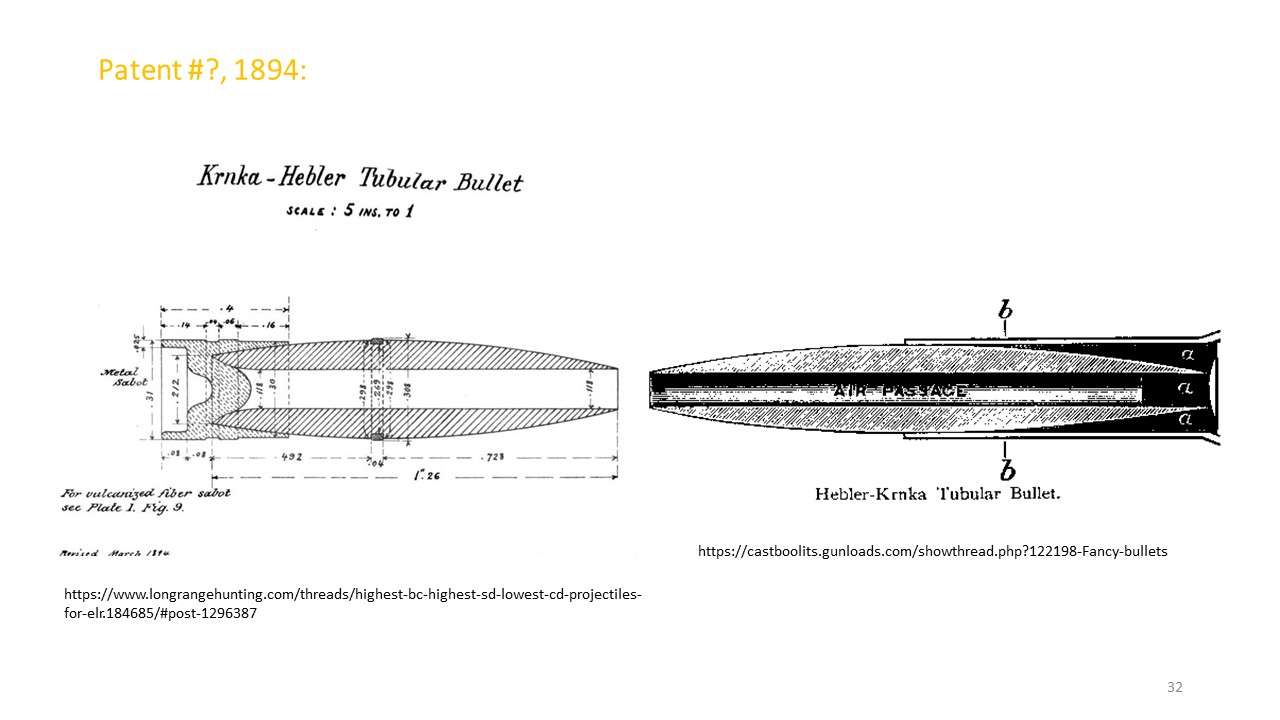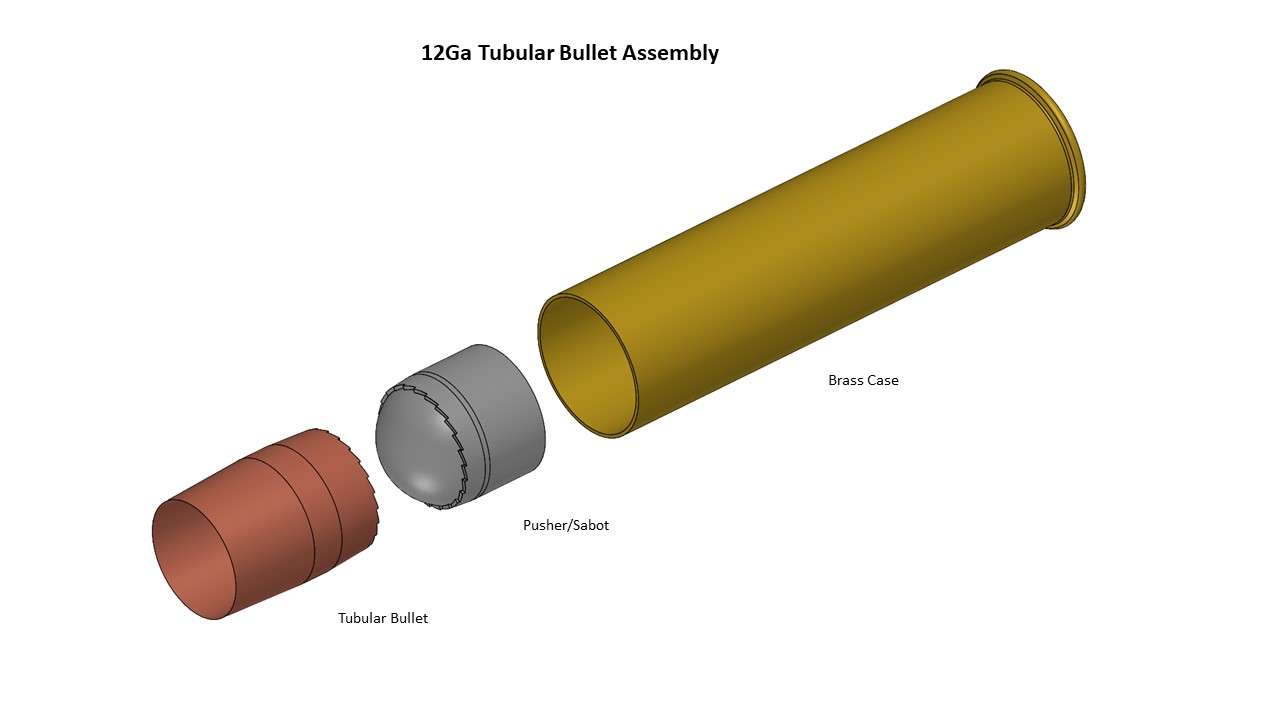This concept is aimed at ultra long range target shooting (Ko2M and similar) where reducing wind effects by minimizing time of flight is important. This design aims to reduce time of flight by increasing muzzle velocity, maintaining that velocity downrange by maximizing the ballistic coefficient, and by having a very flat trajectory.
1. The bullet is a tubular design with a pusher (See the drawing below.) and is based on a 12Ga bore. The bullet weight is 300gr in tungsten and the pusher is 17.75gr in Nylon (PA).
2. A 1750m/s muzzle velocity is the target and the 12Ga bore should allow for the increased force necessary to achieve it. The 12Ga bore gives a 4.5X increase in cross-sectional area vs. the 338 Lapua Magnum and 2.1X vs. the 50 BMG. At a 60,000 psi chamber-pressure the force acting on the tubular bullet would be 24,354 lbf, compared to the 338 Lapua Mag at 5,384 lbf and the 50 BMG at 11,781 lbf.
3. The reduced aerodynamic drag of the tubular design at elevated velocities will help reduce time of flight. At 700m/s the 12Ga tubular bullet has a Cd of ~0.1698. At 700m/s A 300gr 338 Lapua Magnum ‘Scenar’ bullet has a Cd of 0.2848, 68% greater. I didn’t find equivalent 50 BMG info (Velocity + bullet selection…).
4. 12Ga Tubular Bullet Ballistic Coefficient Calcs:
I ran everything through CFD (The second image is a 2D run at 350m/s showing the transonic air velocity behaviour.) to get the Cd numbers (250m/s to 1750m/s. Please see the graph below.) I put quite a bit of time into finding and reading what I could on the tubular/ring bullet/projectile topic, but I am sure I missed plenty. I rolled everything I have (CAD, CFD, patent info, etc.) up and put it on G-Drive for anyone that's interested.
I look forward to hearing what folks think.
Regards,
Jon
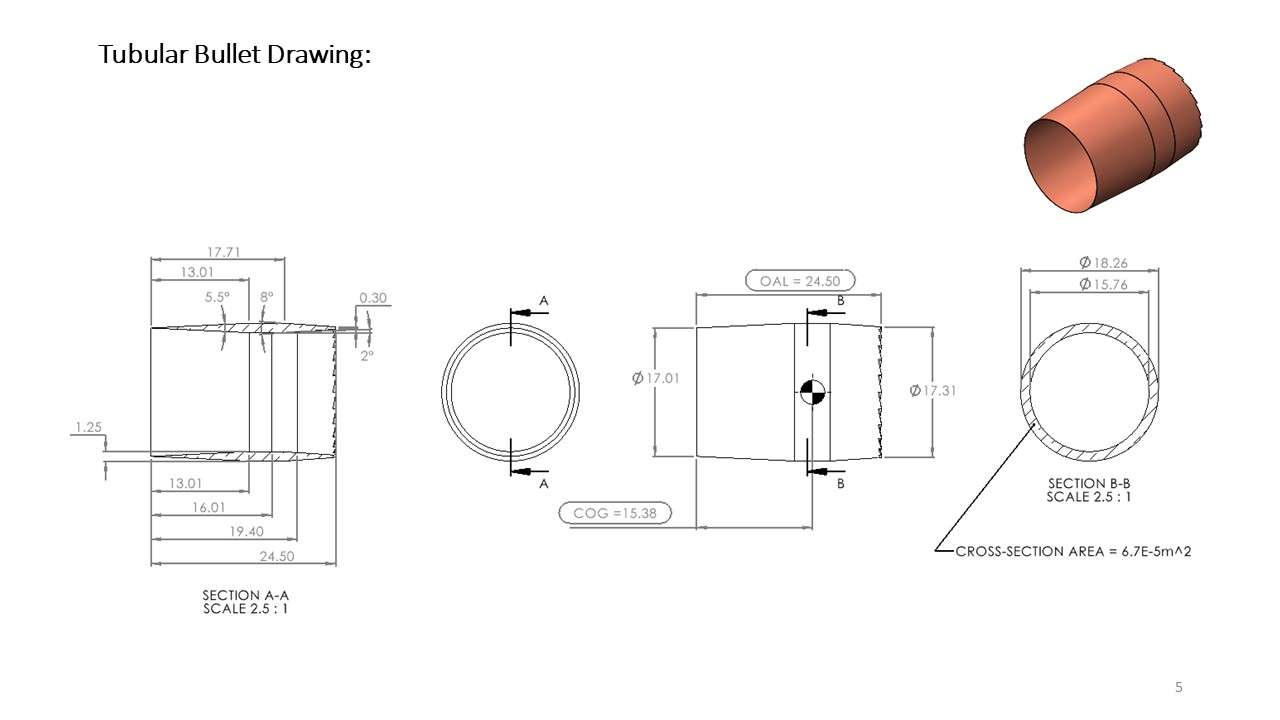
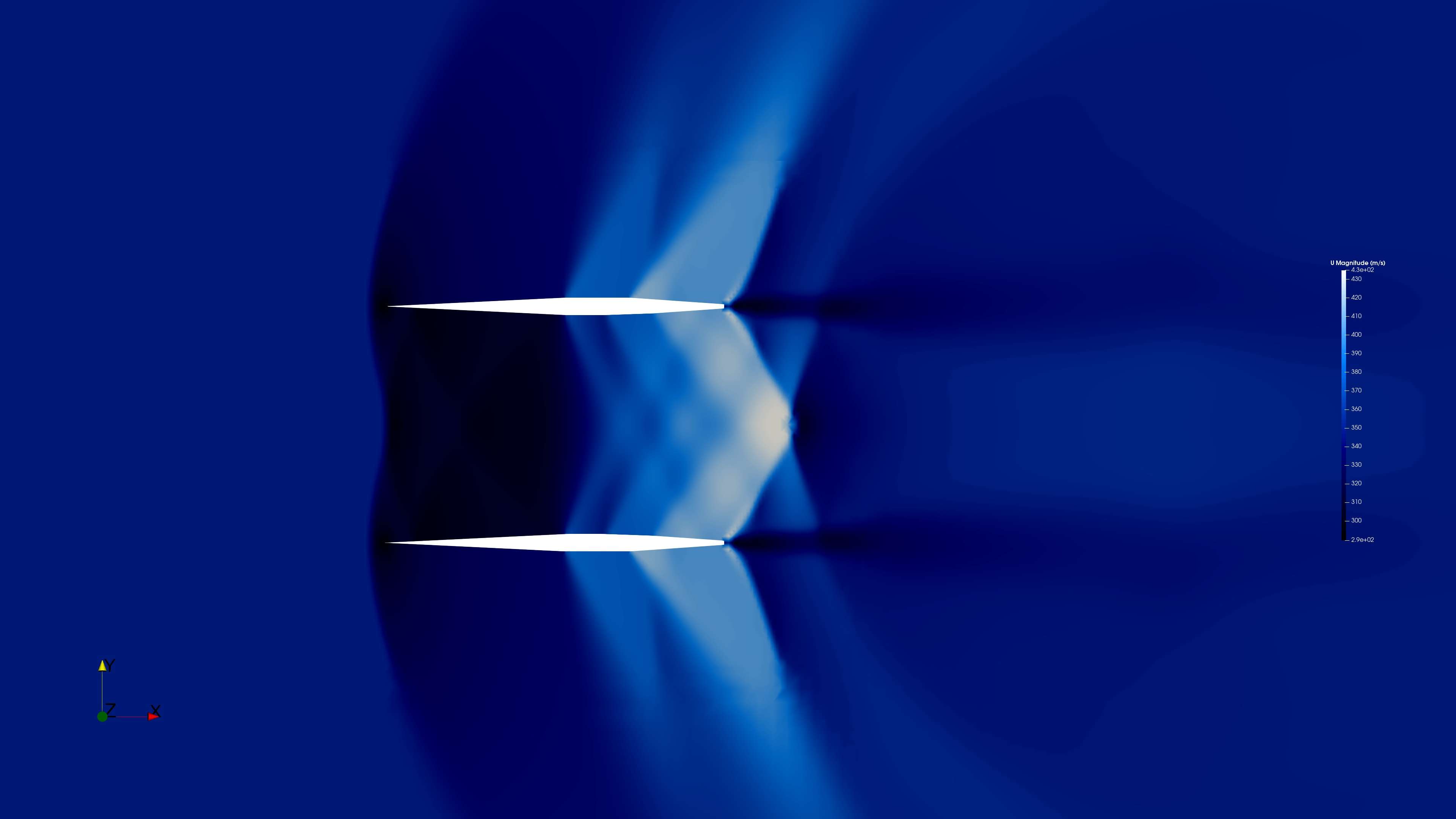
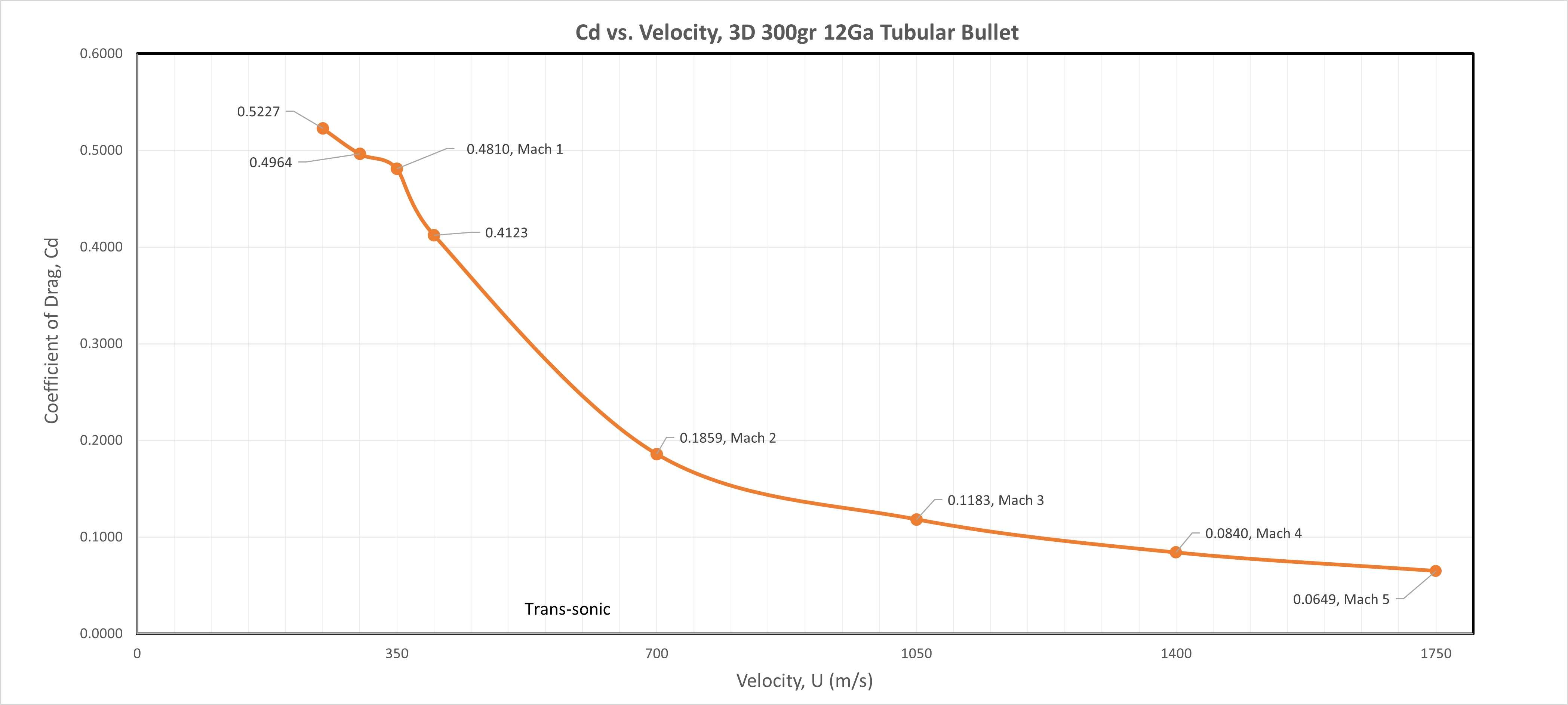
1. The bullet is a tubular design with a pusher (See the drawing below.) and is based on a 12Ga bore. The bullet weight is 300gr in tungsten and the pusher is 17.75gr in Nylon (PA).
2. A 1750m/s muzzle velocity is the target and the 12Ga bore should allow for the increased force necessary to achieve it. The 12Ga bore gives a 4.5X increase in cross-sectional area vs. the 338 Lapua Magnum and 2.1X vs. the 50 BMG. At a 60,000 psi chamber-pressure the force acting on the tubular bullet would be 24,354 lbf, compared to the 338 Lapua Mag at 5,384 lbf and the 50 BMG at 11,781 lbf.
3. The reduced aerodynamic drag of the tubular design at elevated velocities will help reduce time of flight. At 700m/s the 12Ga tubular bullet has a Cd of ~0.1698. At 700m/s A 300gr 338 Lapua Magnum ‘Scenar’ bullet has a Cd of 0.2848, 68% greater. I didn’t find equivalent 50 BMG info (Velocity + bullet selection…).
4. 12Ga Tubular Bullet Ballistic Coefficient Calcs:
- Cd @ 700m/s = 0.1698 (Determined via. CFD)
- W = 300gr
- Cal^2 = (0.104in^2)^2 = 0.0108in^4 (I used the cross-sectional area of the tubular bullet. 0.104in^2, instead of the full 12Ga bore area.)
- i1 = 0.1698/0.593 = 0.2863
- BC1/G = 13.86 = 300/(7000)(0.0108)(0.2863) = 300/ 21.64 = 13.86
- i7 = 0.1698/0.298 = 0.5699
- BC7 / G7 = 6.96 = 300/(7000)(0.0108)(0.5699) = 300/ 43.08 = (G7 = 0.368 @ 700m/s for the 338 Lapua Mag + 300gr Scenar Bullet. G7 = 0.451 for the 50 BMG + 750gr Hornady A-MAX, velocity unknown.)
- Plugging the G7 figure from above and a 1750m/s muzzle-velocity into a ballistics calculator gives the time of flight to 3,500 meters is ~2.1 seconds and the terminal velocity is ~1660m/s.
I ran everything through CFD (The second image is a 2D run at 350m/s showing the transonic air velocity behaviour.) to get the Cd numbers (250m/s to 1750m/s. Please see the graph below.) I put quite a bit of time into finding and reading what I could on the tubular/ring bullet/projectile topic, but I am sure I missed plenty. I rolled everything I have (CAD, CFD, patent info, etc.) up and put it on G-Drive for anyone that's interested.
I look forward to hearing what folks think.
Regards,
Jon




